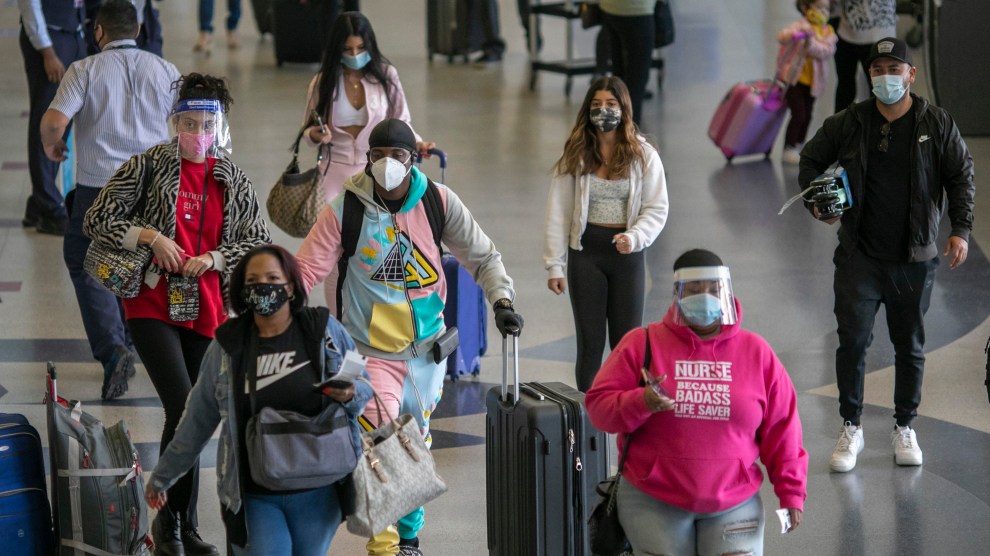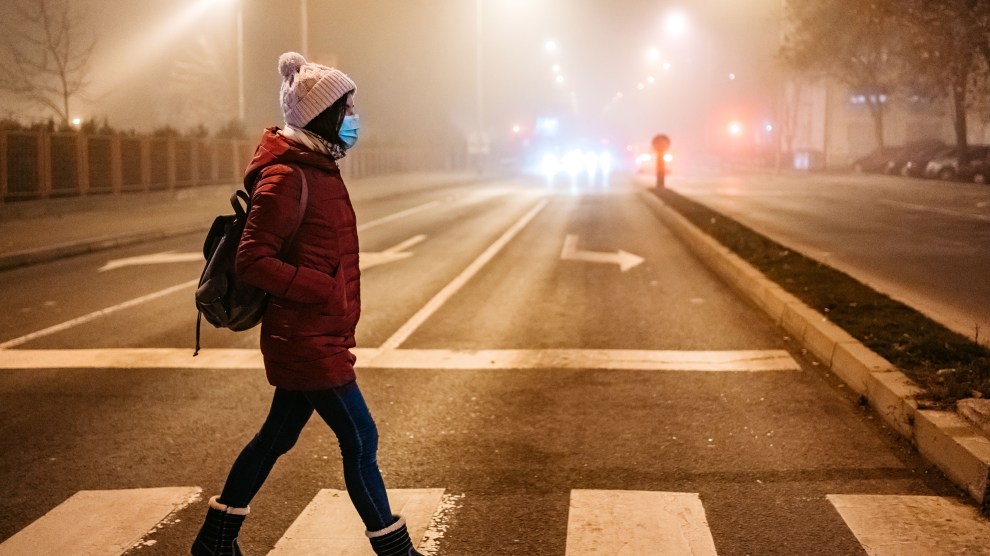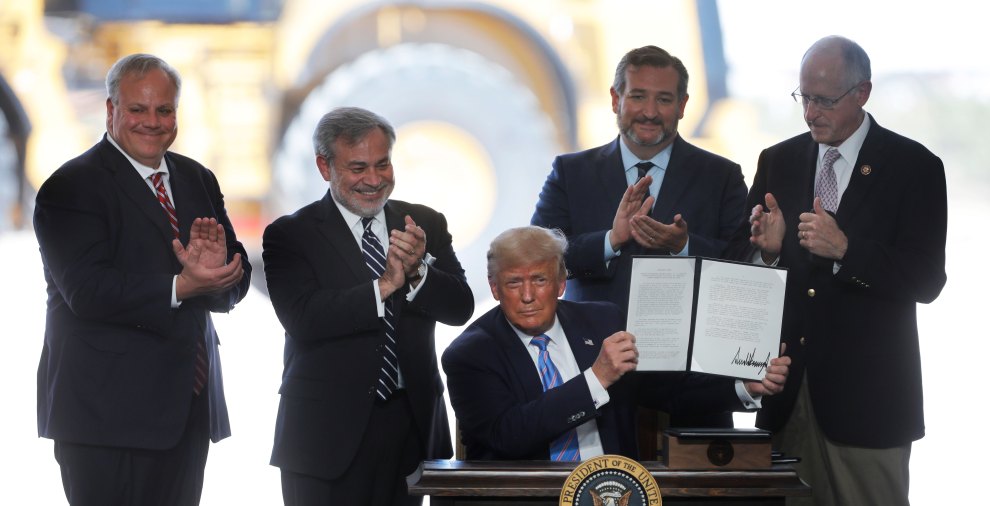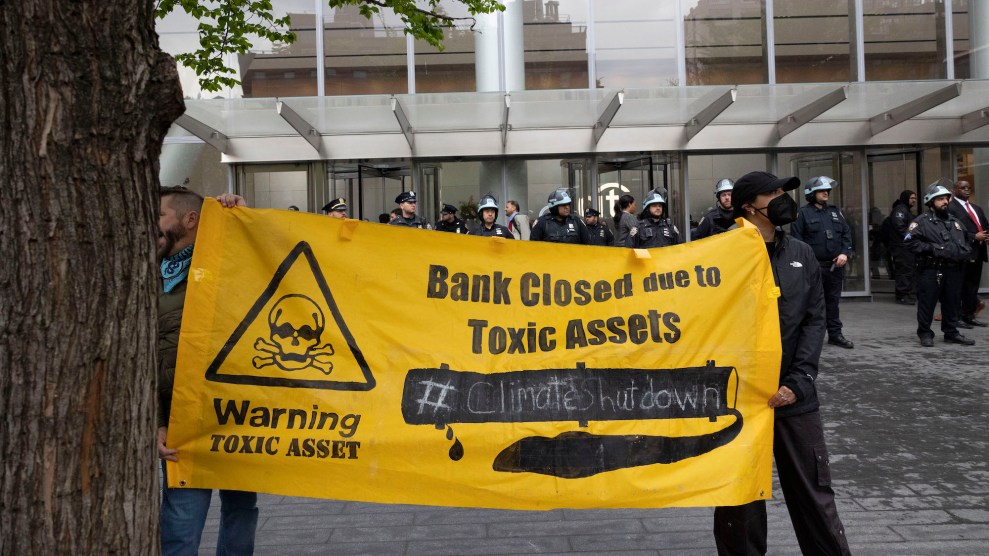
David McNew/Getty
This story was published originally by ProPublica, a nonprofit newsroom that investigates abuses of power. Sign up for ProPublica’s Big Story newsletter to receive stories like this one in your inbox as soon as they are published.
For months after Washington state imposed one of the earliest and strictest COVID-19 lockdowns in March, Jim Gilliard didn’t stray far from his modular home near Waitts Lake, 45 miles north of Spokane.
The retiree was at high risk from the coronavirus, both because of his age, 70, and his medical condition. Several years ago, he had a defibrillator implanted. So he mainly ventured out during the pandemic to shop for food.
There wasn’t much else to do anyway. Gatherings in his county were limited to no more than 10 people, there was a mask mandate, movie theaters were closed and many nightclubs and concert venues were shuttered because of a state ban on all live entertainment, indoors and out.
An hour away in Idaho, life was more normal. The state left key COVID-19 regulations up to localities, many of which made masks optional. Even in places that required face coverings, enforcement was laxer than in Washington. High school sports, canceled for the fall in Washington, were on full display in Idaho. Most Idaho schools welcomed back students in person, in contrast to the remote learning prevailing in Washington. Businesses reopened earlier and with fewer restrictions. There were concerts and dances.
Weary of Washington’s restrictions, thousands of residents made the easy drive over the border to vacation, shop and dine in Idaho. Gilliard resisted temptation until he learned that the annual Panhandle Bluesfest would go on as scheduled near Priest River, Idaho, on Sept. 12. A keyboardist who used to own a blues club just outside Coeur d’Alene, Idaho, Gilliard was buoyed after months of relative isolation by the prospect of hanging out with friends while listening to music on a remote mountainside surrounded by soaring pine trees and thick hemlocks. He decided to go.
A friend took a picture of Gilliard at the festival. Wearing a bandanna fashioned as a headband, a cut-off T-shirt and dark glasses, he was perched on a tree stump and pointing back at the camera. As was permitted by local regulations at the time, he was not wearing a mask, nor were about 10 people sitting together in the background.
As the number of COVID-19 cases skyrockets nationwide, the extent of the public health response varies from one state—and sometimes one town—to the next. The incongruous approaches and the lack of national standards have created confusion, conflict and a muddled public health message, likely hampering efforts to stop the spread of the virus. The country’s top infectious disease expert, Dr. Anthony Fauci, said last month that the country needs “a uniform approach” to fighting the virus instead of a “disjointed” one.
Nowhere are these regulatory disparities more counterproductive and jarring than in the border areas between restrictive and permissive states; for example, between Washington and Idaho, Minnesota and South Dakota, and Illinois and Iowa. In each pairing, one state has imposed tough and sometimes unpopular restrictions on behavior, only to be confounded by a neighbor’s leniency. Like factories whose emissions boost asthma rates for miles around, a state’s lax public health policies can wreak damage beyond its borders.
“In some ways, the whole country is essentially living with the strategy of the least effective states because states interconnect and one state not doing a good job will continue to spread the virus to other states,” said Dr. Ashish Jha, dean of the Brown University School of Public Health. “States can’t wall themselves off.”
A motorcycle rally in August in Sturgis, South Dakota, with half a million attendees from around the country spread COVID-19 to neighboring Minnesota and beyond, according to Melanie Firestone, an epidemic intelligence service officer for the Centers for Disease Control and Prevention, who co-authored a report on the event’s impact.
South Dakota “didn’t have policies regarding mask use or event size, and we see that there was an impact in a state that did have such policies,” Firestone said. “The findings from this outbreak support having consistent approaches across states. We are all in it together when it comes to stopping the spread of COVID-19.”
Viruses don’t respect geographic boundaries. While some states require visitors, especially from high-risk areas, to be tested or quarantined, others like South Dakota have no such restrictions. Many people who are tired of strict COVID-19 measures in their states have escaped to areas where everyday life more closely resembles pre-pandemic times. There, with fewer protections, they’re at risk of contracting the virus and bringing it back home.
After the Idaho concert, Gilliard started feeling ill and was diagnosed with the coronavirus. For about a week, he stayed in bed. As his condition worsened, he was admitted to a Spokane hospital and placed on a ventilator. He died on Oct. 15. His death certificate lists COVID-19 as the underlying cause.
Going to the Idaho festival likely killed Gilliard, his ex-wife, Robin Ball, said.
“If he had been wearing a mask, not shaking hands and keeping distance, he could probably be alive,” she said. “He had been careful before that. He shouldn’t have been up there.”
The degree of coronavirus regulation tends to track political lines. President-elect Joe Biden carried blue Washington state with 58 percent of the vote, while President Donald Trump easily won red Idaho with 64 percent. Trump has helped to fuel the patchwork response to the pandemic, criticizing the approaches of some states, praising others and at times contradicting the advice of his own coronavirus task force and Fauci.
“What really struck me [is] how hard it is to take the pandemic strategy as laid out by the White House with every state on its own and…implement it because every state is not on its own, they are all interconnected,” Jha said.
Biden has said he wants to implement national standards, such as required mask wearing, to help blunt the spread of COVID-19 while acknowledging the federal government has little power to do so. He hopes to work with governors and local officials to establish consistent standards across the country.
A lack of such consistency is affecting eastern Washington, which appears to be absorbing some of the costs—both human and economic—of Idaho’s more laissez-faire approach to the virus. The rate of new cases in and around Spokane, near the Idaho border, is far higher than in Seattle and western Washington, which experienced one of the earliest outbreaks in the country in February. Although slightly more than half of recent COVID-19 cases in Spokane spread among households or personal contacts, Spokane Regional Health District epidemiologist Mark Springer said, “people bringing back COVID-19 from larger events in Idaho” has been a problem. And with Idaho’s rate of new cases now doubling Washington’s, Idahoans who commute to the Spokane area pose an outsized danger. At the same time, Washington’s shuttered businesses have ceded customers to their Idaho competitors.
Public schools in Washington have also suffered. After opening the school year with remote-only instruction, the Newport School District lost about one-fourth of its 1,200 students. Most of them opted either for specialized online-only programs or for nearby private and public schools across the border in Idaho, which offered in-person learning and sometimes didn’t require masks or social distancing, said Newport Superintendent Dave Smith. The plunge in enrollment has led to a $1.2 million drop in funding, he said.
In early October, Newport began some in-person learning but had to return to remote instruction after a COVID-19 outbreak in the community. The source was traced to a Christian church and school only a few feet from the Washington border in Oldtown, Idaho.
“It’s incredibly frustrating,” Smith said. “I certainly think aligned standards across the nation would have changed our situation.”
Washington Gov. Jay Inslee recently called on “Idaho leaders to show some leadership” and be more aggressive in combating COVID-19. He blamed the virus spread in Idaho for straining Washington hospitals. For their part, some in Idaho have complained that the rise of COVID-19 there has more to do with the influx of Washington residents over the summer and fall than with a lighter regulatory touch.
Many of those Washingtonians headed to Coeur d’Alene (pop. 52,400), the seat of Kootenai County and the largest city in northern Idaho. Despite some cancellations, many tourism activities went on as scheduled. The Spokesman-Review newspaper in Spokane ran a feature headlined, “A nearby escape: Coeur d’Alene Resort offers amenities for singles and families.” The resort, the article noted, was offering special packages for families that include a pizza-making experience, scenic cruise tickets and discount theme park tickets. In the resort garage, most of the license plates were from Idaho or Washington.
“Yes, the coronavirus exists,” the article continued. “However, the luxe Coeur d’Alene Resort is open and taking steps to make an experience as safe as possible.” While employees wore masks, the article said, they were optional for guests and about two-thirds opted not to use them. The resort did not respond to requests for comment.
At a park in downtown Coeur d’Alene, a weekly concert series called Live After 5 attracted crowds all summer. Though attendance was lower than in prior years, it swelled as promoters targeted marketing to tourists, concert organizer Tyler Davis said. At one show in July, a member of the band surveyed the large gathering and said, “Look around you guys, it feels kind of normal tonight.” Groups of people danced in front of the stage, food trucks lined up along one side and vendors set up tents. Masks were “encouraged but not required.”
The day after that show, the Panhandle Health District encompassing five Idaho counties ordered a mask mandate in Kootenai. It required masks in indoor and outdoor public places when a social distance of six feet could not be maintained.
Springer, the epidemiologist, watched the flow of Spokane County residents to Idaho with concern. “The issue with Idaho is a somewhat significant one for us in that the restrictions are a pretty stark contrast between what is in Idaho and what we have in Washington,” he said. “Coeur d’Alene is a sister community to us.”
Jim Gilliard was a popular figure in the blues music community around Spokane and northern Idaho. In the 1990s, he operated a music club outside Coeur d’Alene called Mad Daddy’s Blues. He was a talented musician himself, playing keyboards in local blues bands, even after losing a finger and badly injuring two others in a table saw accident.
Gilliard was raised in New York City and Pennsylvania. His father, E. Thomas Gilliard, was an acclaimed ornithologist who served as curator of birds at the American Museum of Natural History and was often gone for months at a time on expeditions to New Guinea. After Gilliard met Ball, the two headed to Colorado and enjoyed life as ski bums, moving from resort to resort for a couple of years before eventually settling in Coeur d’Alene, and having a son. After they divorced two decades ago, she stayed in Coeur d’Alene and he ended up in the village of Valley, Washington. (pop. 164).
Gilliard was one of nearly 300 people who paid $25 each to attend the blues festival, which was held 2 miles up a mountain road outside Priest River, Idaho, a tourist town 6 miles from the Washington border.
Bonner County, where the concert was held, is a rural pocket of defiance against government public health mandates related to the coronavirus. When the local library instituted a mask requirement for users, mask-less demonstrators, some clutching small children, protested and tried to enter the library as staff members stood their ground and explained they were only trying to prevent people from getting sick. The county sheriff wrote to the governor criticizing lockdown orders early in the pandemic, alleging that public health officials misled the public and that “COVID-19 is nothing like the plague.”
Concert organizers Billy and Patty Mullaley said they waited until the end of June before deciding to go ahead with it. The only potential roadblock was getting liability insurance at an affordable price during a pandemic, which they were able to do after shopping around.
“At the time, there were not any restrictions” on events like theirs in Idaho, Patty Mullaley said. “We did not take it lightly, having the event. We really put thought into it.” They bleached outhouses and the area around the concert stage offered plenty of space for social distancing, she said. Among those most grateful they went ahead, she said, were musicians who had been starved for gigs because of coronavirus-related cancellations. Featured acts included Sammy Eubanks, Coyote Kings and Tuck Foster and the Tumbling Dice.
Mullaley said the festival drew Washington residents eager for events banned in their own state. “From my experience, everyone and their dog from Washington was over here,” she said. “Our COVID is probably from people coming over here from Washington.”
Few of the hundreds of people at the festival wore masks and many didn’t stay socially distant, according to attendees. “Part of what made it magical was people were completely free and happy and not fearful at all,” said Sylvia Soucy, who had COVID-19 earlier in the summer. People danced barefoot on the soft sand and mingled with friends, she said.
Mullaley said people socially distanced “as much as possible.” In the end, she said, “these were all adults” who made individual decisions. Soucy agreed. “It was completely a choice all of us made,” she said. The remote setting—no cellphone service, no electricity and surrounded by hundreds of acres of undeveloped forest—added to the temporary joy of escaping from the virus, Soucy said.
Soucy said she talked to Gilliard there and he was in good spirits, “glad that people were not worried about being able to get together there on the mountain.” Gilliard also chatted with other friends, including a former girlfriend, according to Soucy. Ball said the former girlfriend was diagnosed with COVID-19 shortly after the festival and notified Gilliard.
“I don’t know why he let his guard down,” Ball said. “I will never understand that.” In the end, she thinks it had to do with “a long summer of not having a lot of stuff to do. He had been so cautious for those seven or eight months. He just didn’t feel like it was going to be a problem.”
The Mullaleys said they were unaware of anyone else from the concert getting COVID-19 around that time. But some Washington residents who tested positive for the coronavirus told contact tracers that they had attended the blues festival, according to Matt Schanz, the administrator of Northeast Tri County Health District, a public health agency in Washington covering counties near the Idaho border.
That doesn’t definitively mean that they contracted the virus at the festival, he said. “We have 550 cases within three counties, and if you read the summary reports, a decent number of those have some affiliation with Idaho,” Schanz said.
South Dakota has largely remained open for business during the pandemic. Gov. Kristi Noem, an ally of Trump’s, has refused to impose a mask mandate, saying there are questions about its effectiveness. The state has not placed any restrictions on bars and restaurants and officials allowed the 10-day motorcycle rally in Sturgis. Such a rally would have been prohibited in Minnesota. Both Minnesota and South Dakota are in the top five states when it comes to rates of cases per capita over the last week.
The CDC advises that outdoor events are less risky than indoor ones. The Sturgis rally, which featured events in both settings, is now linked to at least 86 COVID-19 cases in Minnesota, including four people who were hospitalized and one death, according to a CDC report released in November. The report said the total is likely an undercount as some of those infected declined to share their close contacts with health officials.
“These findings highlight the far-reaching effects that gatherings in one area might have on another area,” the researchers wrote. They added, “This rally not only had a direct impact on the health of attendees, but also led to subsequent SARS-CoV-2 transmission among household, social, and workplace contacts of rally attendees upon their return to Minnesota.”
Mike Kuhle, the mayor of Worthington, Minnesota, said South Dakota’s approach to the pandemic “is a source of heartburn for me and sleepless nights.” His city is close to both the South Dakota and Iowa borders. In addition to worries about the virus spreading from South Dakota, Kuhle said, “during the lockdown people have gone to Sioux Falls for shopping. It’s ugly for our businesses.”
A similar dynamic has played out in the Quad Cities area at the border of Illinois and Iowa. There, thousands of people cross bridges over the Mississippi River every day to work, visit family and shop in each state.
As cases in Iowa began to surge this summer, Gov. Kim Reynolds dismissed mask mandates as “feel-good” measures that are difficult to enforce. Until recently, Iowa restaurants and gyms were allowed to operate at full capacity as long as social distancing measures were in place. There was no state-imposed limit on the size of social gatherings. Nicknamed “COVID Kim” by her critics, Reynolds changed course in mid-November in the face of surging cases and hospitalizations, requiring masks.
Illinois clamped down earlier and harder, instituting a mask mandate at the end of April. Movie theaters opened in Iowa before those in Illinois. Iowa never closed its golf courses when neighboring states like Illinois did.
For Illinois businesses, the gap between the two states’ regulations has been crushing, said Paul Rumler, the president of the Quad Cities Chamber.
“A river runs through it but otherwise this is one community,” he said. On the Illinois side, “we have retailers and restaurants who want to be responsible corporate citizens and follow the guidelines knowing they are at a disadvantage from a business literally 3 miles away.”
Rumler said the chamber advocated for the two states to have a consistent approach to the pandemic to no avail. “If there was a federal standard, it would eliminate the confusion of our region,” he said. “It would make our life a lot easier.”
Debbie Freiburg, a volunteer contact tracer for the county encompassing the Illinois side of the border, said the looser restrictions in Iowa offered Illinois residents the chance to “take a break” from the virus.
“It’s bad and the differences are huge, unfortunately,” she said. “I can be in Iowa in 10 minutes, and there were a lot of us going shopping in Iowa.”
Freiburg, who retired to the area after working as a pediatric cancer nurse in Washington, D.C., said cases in her Illinois county have been tracked to Iowa, including several from a large wedding at a hotel just over the border.
Tensions between Washington and Idaho over their divergent responses to the pandemic escalated in October. As the count of COVID-19 cases climbed, the board of the Panhandle Health District in Idaho voted 4-3 to rescind the mask order it had imposed on Kootenai County three months before. Officials in Washington were stunned. Inslee, the governor, refused to rule out restrictions on border traffic.
The move by the health board came amid growing resistance in the state to mandatory public health measures to control the virus and skepticism that COVID-19 was even real.
A group of Idaho politicians, including Lt. Gov. Janice McGeachin, appeared in a video in October urging the state to limit restrictions. Sitting in a truck with an American flag draped over the side, McGeachin placed a gun over a Bible. “We recognize that all of us by nature are free and equal and have certain inalienable rights,” she said. A legislator in the video said “the pandemic may or may not be occurring.”
State Rep. Tony Wisniewski, who represents Kootenai and also appeared in the video, urged the health board to make masks optional. He compared the mask mandate to what he said was a requirement in Nazi Germany to tell authorities if a neighbor was Jewish.
Health board member Allen Banks said he was “deeply suspicious” of tests for COVID-19. In an email to a senator who had criticized the board’s mask mandate, he wrote, “I hope you and the legislators who support your effort will continue to stand for truth rather than the fantasy of a phony disease based on a false test.”
Board member Walt Kirby, who had voted in July to approve the mask mandate initially, was the deciding vote. He opposed a mandate because people were “pretty damn nasty” to him for supporting it before, he explained. “I am not going to vote for it, I am just not because no one is wearing the damn masks anyway,” Kirby said, adding that he wears a mask. As for people who ignore the advice of public health experts, he said, “I am just sitting back and watching them catch it and die and hopefully I will live through it. You know I am 90 years old already and I am not getting involved in it anymore.”
Even as the requirement was rescinded, cases in Kootenai were soaring. The rate of hospitalizations in the border area in northern Idaho is nearly double the rate in the Spokane region. Overall, the number of new cases in Idaho per capita is almost twice that of Washington.
With the county mandate overturned, the city of Coeur d’Alene considered in late October whether to adopt one on its own. Mayor Steve Widmyer and the City Council were inundated with hundreds of emails and telephone calls, many from mask opponents.
“This is Idaho, not Washington or California,” wrote one resident. “Let the people decide if they wish to mask up or not.” Another told the city leaders, “If you want to live with a mask ‘muzzle’ on your face move to California or Washington.”
Ball, Gilliard’s ex-wife, urged Widmyer to support a mandate. “People come here so they don’t have to wear a mask and fill our bars and businesses while spreading covid,” she wrote.
In Coeur d’Alene, the mayor only votes to break a tie among the city councilors. Widmyer, who had complained that city officials “shouldn’t have been put into this position,” didn’t have to vote, because the council approved the mandate 4-2 on Oct. 26. Protesters outside chanted, “No more masks, we will not comply,” and the blowback has been swift. A group of residents is pushing to recall the pro-mandate councilors. The mayor did not respond to interview requests.
While Coeur d’Alene adopted a mandate, nearby Post Falls and Hayden rejected similar proposals. All three cities are less than 20 miles from the Washington border. Idaho Gov. Brad Little has also remained steadfast in opposition to the idea, unlike Iowa’s Reynolds. “Idaho’s health officials have been mindful of the challenges of mitigating spread of COVID-19 in border communities since the onset of the pandemic,” a spokeswoman for Little said in an email. The governor’s “priority at this time is mitigating the spread of COVID-19 in Idaho and preserving health care capacity for those in need.”
For the Panhandle health board, however, the situation became too dire to ignore. On Nov. 19 it reversed itself again and passed a mask mandate for all five of its counties, including Bonner, the site of the blues festival. But county sheriffs have ignored enforcing the mandate or made it a low priority, according to local media.
The move came too late to save Gilliard. “Until everyone in this country can do the same thing, all states on the same page, limit crowd size and mask mandates that are enforced, this is going to happen,” said Ball, his ex-wife. “It only makes sense. Because what we have been doing hasn’t been working.”















